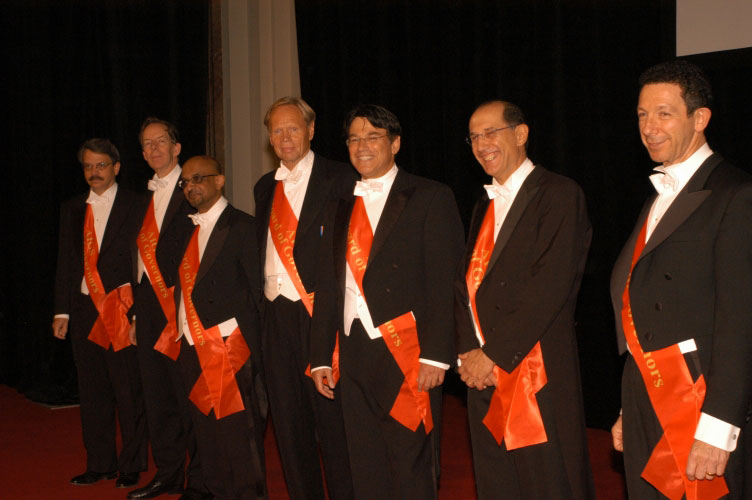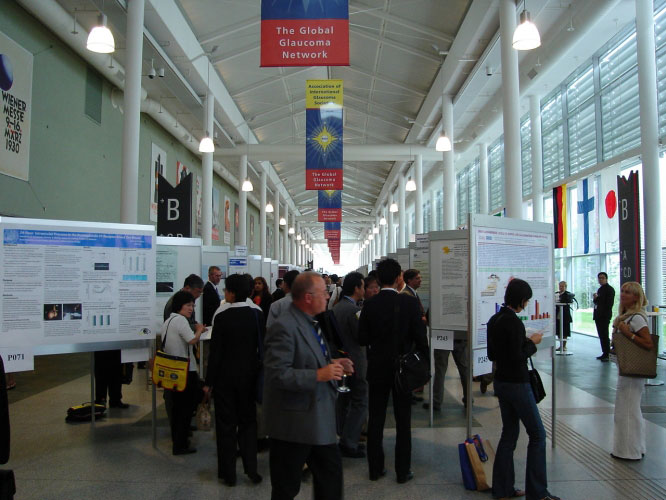advertisement

The WGA World Glaucoma CongressJuly 6-9, 2005, Vienna, Austria | R.N. Weinreb and E.L. Greve
It was a historical meeting, the realization of a vision: bringing together all those involved in glaucoma. The level of enthusiasm for this worldwide cooperation is high and quite stimulating. The National Glaucoma Societies were each introduced not only through
their representatives, but also through an informative poster and
through the presentation of essential data in the WGA Directory of
Glaucoma Societies. The Opening Ceremony of the World Glaucoma Congress started with Alle Menschen werden Brüder - All people become brothers (and sisters) - Friedrich Schiller's majestic poem of which the music, composed by Ludwig Von Beethoven, originates in Vienna.
The concept of the WGC was to provide to its audience top-quality scientific information which should be useful in the daily clinical practice of treating glaucoma patients. The concept was realised by:
The program contained information on virtually every practical topic, as can be seen on the WGA website. For Poster-Recognitions and WGA-Award see pages 181 and 185. Did the concept work? First of all the exceptionally high number of participants speaks for itself. The WGC was the largest glaucoma meeting ever organized. The majority of the participants filled out an evaluation form covering several aspects of the meeting. Ninety-five percent of the participants were satisfied with the meeting and seventy-five percent considered the meeting better than average. Several aspects of the concept were particularly appreciated, such as the didactic lectures followed by courses on the same topic, and the interactive questions. The congress showed that the combination of science, education and social gathering is a necessary and much appreciated endeavour. Finally, high scores were given to overall content and concept of the WGC. We may conclude that the participants expressed a high level of satisfaction on virtually all aspects of the meeting. Despite these outstanding reviews, we have several suggestions for improvement. Many of these suggestions will be implemented during the planning of an even greater WGC in 2007. We thank all of you who attended, co-glaucomatologists who were involved in the organization, our Industry members who supported the meeting and our 140 faculty members who provided the extraordinary high level of didactic presentations. |

 The World Glaucoma Congress (WGC), organized by the WGA, attracted 2144
participants of which 1864 took part in the scientific program.
Participants came from all over the world with a majority originating
from Europe. The opening of the WGC was preceded by the Inaugural
Assembly meeting of the WGA which gathered, for the first time ever,
representatives from 63 regional and national Glaucoma Societies from
around the world, representatives from Glaucoma Industries and
representatives from Glaucoma Patient Organizations.
The World Glaucoma Congress (WGC), organized by the WGA, attracted 2144
participants of which 1864 took part in the scientific program.
Participants came from all over the world with a majority originating
from Europe. The opening of the WGC was preceded by the Inaugural
Assembly meeting of the WGA which gathered, for the first time ever,
representatives from 63 regional and national Glaucoma Societies from
around the world, representatives from Glaucoma Industries and
representatives from Glaucoma Patient Organizations.
 Dr. Otto Von Habsburg, the last crown-prince of Austria and guest of
honour, gave the opening lecture (at the venerable age of 93 years)
which appropriately dealt with international cooperation. His eloquent,
knowledgeable and witty speech not only stressed the unique opportunity
for medical specialists to unite at a worldwide level, but also that
advanced age may be enjoyed in the full possession of mental sharpness.
The subsequent speakers discussed the state of the art of glaucoma at a
global level. The ceremony was ended by the newly composed WGA Glaucoma
Hymn (which can be heard and downloaded at
Dr. Otto Von Habsburg, the last crown-prince of Austria and guest of
honour, gave the opening lecture (at the venerable age of 93 years)
which appropriately dealt with international cooperation. His eloquent,
knowledgeable and witty speech not only stressed the unique opportunity
for medical specialists to unite at a worldwide level, but also that
advanced age may be enjoyed in the full possession of mental sharpness.
The subsequent speakers discussed the state of the art of glaucoma at a
global level. The ceremony was ended by the newly composed WGA Glaucoma
Hymn (which can be heard and downloaded at
